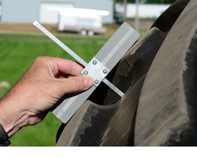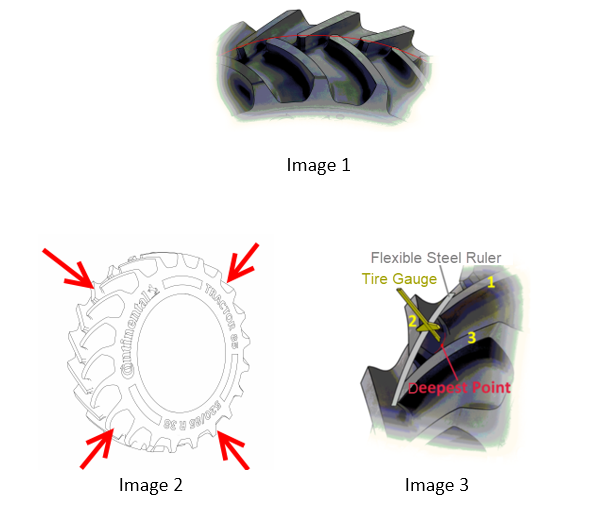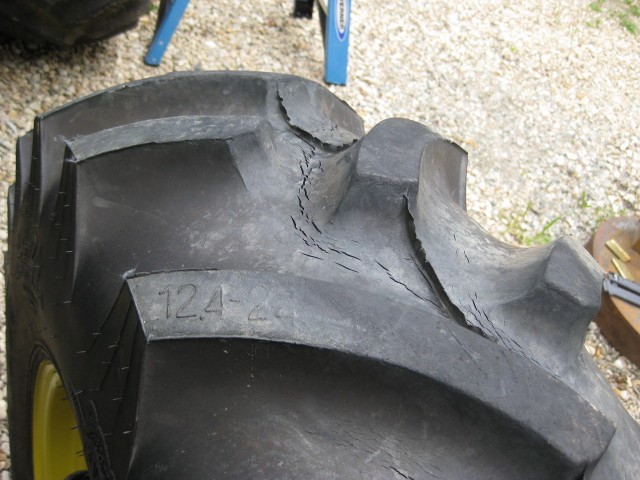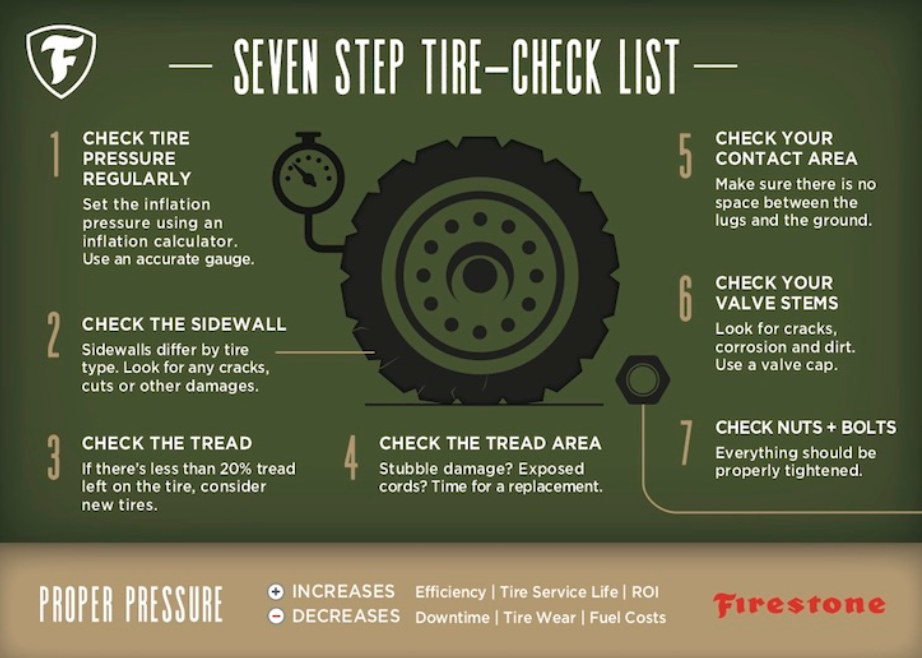Editor’s Note: This Q&A originally appeared in AG Tire Talk to provide answers that farm equipment dealers have about farm tire technology. This series features a trending question followed by an abridged version of the answers. For the complete answers, check out www.agtiretalk.com.
What off season storage and pre-season preventative maintenance steps should a grower take to reduce downtime? When do you consider R-1/R-1W worn out and what is the best way to measure tread depth?
Alliance Tire Americas, James Crouch, National Product Manager-Agriculture
As you get ready for the growing season, inspect your tires carefully. Make sure you don’t have any nails or other objects wedged into the tire (you’d be surprised what can have escaped your notice). Check sidewalls for blisters that indicate separation or impact damage, and for slashes or cuts that could threaten the integrity of the casing. Look over your tread for wear, chunking or cracks.
And, of course, adjust your inflation pressure to the proper level for the load and speed you will be operating at.

Invest in a tread depth gauge. They’re not expensive, and they’re easy to use. All you have to do is rest the feet of the gauge on your tread lugs or blocks and extend the probe into the space between the lugs. The key is to do it several times at different places in each tire. That way, you’ll pick up indications of uneven wear, which are important for determining whether your inflation pressure has been correct, and whether you need to rotate your tires more frequently.
Examining tread depth is important in determining whether your tires are worn out.
There’s no real, set number for when a farm tire is worn out. Obviously, if you see cords or damage, it’s time for a new tire. But there’s a little wiggle room on tire replacement based on what you expect that tire to do. If you’re counting on great traction to pull a disk or a planter, you’ll need some rubber on those lugs to get a good grip-same thing if you tend to run in muddy or slick conditions.
However, if the weather is dry or we’re just talking about a chore tractor that you use to pull a feed mixer or haul things around the yard, you might be able to squeeze an extra season out of a set of tires that are down to 20/32″ or so.
Continental Agriculture North America, Albert Sumera, Continental Commercial Specialty Tire Technical Solutions
Agriculture tires are normally used for a long period of time, however in instances when there is an observed substantial slippage (approximately more than 15%) depending on the surface of operation, the tires may be considered “worn out”. Being worn out is relative to where the machine and tires are being used and there is no general principle that can be applied to every situation.
Agriculture Tire Tread Depth Measurement:
- Tread measurement should be made on properly mounted tires. Tires normally grow after first inflation. This effect is very significant the first few hours and can go on for the rest of tire life in minimal dimensions.
- Recommendation for precise measurements at “new” condition:
- Set air pressure to 2.0-2.5 bar (29-36 psi) at mounting
- Run the tires for a few miles on road at max tractor speed
- Adjust the air pressure to the operating air pressure
- Measure the tread depth the next day (24 hours later)
- Because of difficulty and variance in measurement of tread depth of agriculture tires, it is decided to use the center-line as the simplest measurement method.

- Measure on four locations along the center-line of the tire (see image 2).
- Use a flexible steel ruler to align with the round shape of the tire diameter by pressing the top of the ruler to the inside of lug 1 and the bottom of the ruler to the inside of lug 3 (see image 3). If a flexible steel ruler is not available, you can also use a hack saw blade.
- Measure with a tire gauge down to the deepest point between lug 1 and 2 (see image 3).
- We recommend measuring the tires every 500-1,000 hours, but the first measurement after fitment should be done earlier. During the first 100 hours the wear rate is generally higher (which is normal for all types of tires).
BKT USA Inc., Dave Paulk, Manager Field Technical Services
- Tires should be checked for cracks, cuts, bulges, or any other type of visible damage. If there is any damage or possibility for failure, this gives time to replace or repair tires before they are needed again. Be sure to check tread depth. If the tire has less than 20-25% tread left, the tires may need to be replaced sometime during the next year. This gives the farmer time to budget for new tires.
- Make sure lug nuts are tightened to correct specifications. Check the bolts for wheel weights to ensure they are tight.
- Inflate tires to the maximum recommended inflation pressure by the manufacturer for storage. Ambient air temperatures can cause air pressures to move up and down during the winter months when the equipment is not in use. Air pressures generally decrease in cold weather, causing the tires to go flat if they are not inflated enough. If tires go flat during the winter, the rim can damage the sidewalls by sitting on them. It is a good idea to check tires periodically while the equipment is stored to ensure they don’t go flat. When taking the equipment out for use after storage, set air at correct recommended pressures to carry the weight of the tractor and equipment. This will ensure the tire is not damaged and will minimize soil compaction. Do not drive on flat tires.
- Make sure tires are clean before storage. Clean the mud, sticks, and rocks from lugs and remove mud from the rim and weights (if wheel weights are used). In general, it is a good idea to store the equipment clean. When it is used again, it is ready to go.
- If possible, it is best to store equipment inside in a cool and dry place. This keeps the sun, wind, rain, and snow from weathering the tractor and the tires. Ozone in the air and sunlight can cause rubber to age prematurely. It is best to keep rubber products away from electric motors, oils, fuels, and resins. If the tractor will be sitting for several months or more, it is best if the tires are not parked on rocks or asphalt. Rocks can damage tires if they lose air pressure. Also, asphalt is an oil-based material that will cause rubber to deteriorate over time. If the tractor must be left outside, cover the tires with a waterproof tarpaulin to avoid contact with ultra violet rays and bad weather.
There is really no cut and dried way to determine when it is time to replace tires based on tread depth. A tire that needs to be replaced in wet dirt may be fine in dry dirt. As tire lugs wear down, they can start slipping excessively which can increase fuel costs and time.
Titan International, Inc. (Manufacturer of Titan and Goodyear Farm Tires), Scott Sloan, Ag Product Manager / Global LSW
Ag tires are designed to withstand the usage conditions of their respective application, but in order to achieve their full performance potential they must be maintained appropriately, which includes the condition in which they are stored in the off season in order to minimize the chance of experiencing an ozone/weather cracking condition over the winter months when the equipment is inactive.

In a perfect world the best case scenario would be to block equipment off the ground to remove the load and let air out of the tires to relieve the stress on the tire surface. In addition, the unit should be stored in a covered environment away from sources of ozone which would include electric motors/machines, engine exhaust, welding equipment, battery chargers, transformers, and mercury vapor lamps. Other equipment that may produce sparks or electrical discharges should also be avoided. Covering the tires with an opaque wrap will eliminate the chances any UV light to attack the surface of the tires. I realize that it seems like a lot of work, but if you follow any of these suggestions or you realize you are accidentally exposing your tires to harmful elements you can take whatever counter measures to minimize the risks.
Depending on who you talk to and the applications, tires can run for decades and be literally smooth and they still perform the job just as well as the day they installed them. Of course those are rare but my point is that depending your performance expectation the idea of “worn out” may differ.
Of course those are rare but my point is that depending your performance expectation the idea of “worn out” may differ. Most companies will consider a tire “worn out” when the tread depth is less than 80% or 90% of the original tread depths.
Precision Inflation LLC, Ken Brodbeck, VP of Technology
At the end and beginning of the season:
- Check TIRE PRESSURE!! Inflate to recommended plus 2 to 3 psi for weather changes. A tire monitoring or On the Go Inflation System makes this simple!
- Check for any cuts or breaks in the tire tread, shoulder, sidewall and bead area.
- Is there irregular tread wear? This may stem from over or under-inflation!
- Store tires in a dark and electric motor/welder free area. Sun and ozone kill tires.
- Keep petroleum-based liquids and grease away from tires.
- Reset tire pressure at the beginning of the season for the machine’s heaviest load, such as a large front fold planter.
- At a minimum, check tire pressure once per week during use.
When to put the tire/horse out to pasture?
1. When the R-1 or R-1W tire will no longer do the job!
- Excessive slippage in heavy drawbar applications
- Will no longer hold air and cannot be repaired
- There are numerous cuts or cracks into the tire cord body
- Your favorite tire dealer has a special rebate deal. A half worn tire may value to trade in for a new set of shoes!
- If you need to measure tread depth, choose the worst wear location, lay a straight edge across two tread bars and measure to the base of the tire with a ruler.
Michelin, AgDavid Graden, Operational Market Manager – Agriculture
The reality is, there are only a couple of simple actions a machine owner should take to help maximize the life of their tires and ensure optimum performance the following season.
I recommend parking your machine in a cool dry place. Washing your machine thoroughly will show evidence of any fluid leaking throughout the storage period. Additionally, make sure your tires aren’t sitting in chemicals, hydraulic fluid, fuel or oil. Petroleum based fluids will eat rubber and cause your tires to crack at the contact area.
Next, raise the air pressure of your tires to the maximum air pressure recommended on the sidewall of the tire. As the ambient temperature falls, so does the psi in your tires in addition to the natural loss of air pressure over time. When you return to use your machine, and pull out of storage for the season, reset your air pressures to the recommended psi. Your tire manufacturer representative should be able to assist you with this. As I have stated before, all Michelin Ag reps have the capability of weighing machines and recommending exact air pressures to help your machine perform exceptionally well.
If you wanted to keep an eye on your tread and track my thoughts here, Michelin recommends taking tread measurements at the center of the tire, at the lug nose. If your tire pressures are set to recommended psi for the weight carried, your tires should wear nice and evenly across the face of each lug. If your tires are not wearing this way, you could have a mis-mounted tire or have a mechanical issue causing that tire to wear unevenly. Consult your manufacturer’s rep for recommendations or diagnostic.
Trelleborg Wheel Systems, Norberto Herbener, OE Applications Engineer
There are several points to consider when checking tires during the off season:
- Check for external damage that could compromise the tire’s structural integrity or performance.
- Check for correct bead seating on the rim and potential tire to rim slippage.
- Check the bead area for material between the bead and the rim.
- Check the tire for signs of any uneven or excessive wear pattern that can be related to incorrect tire inflation pressure, incorrect tire size selection (that differ from a correct lead value depending on the tractor inter-axle ratio), excessive tire to soil slippage or damage/wear on steering components.
- Check the height of the lugs and replace the tires if the lugs are below 20-30% of its original height.
- It is always recommended to store the equipment inside a shed and away from direct sunlight.
- If possible, lift the equipment and place it on stands to allow the weight of the load to be released from the tires.
- If the tires are removed from the equipment to be stored during the off season, for example a floater set for sprayers, be sure to store them standing upright.
- Clean the tires as much as possible to remove dirt and other debris.
- Don’t allow the tires to come in contact with petroleum-based products or solvents.
- It’s recommended, when replacing worn out tires, to choose the same brand and size already installed for each axle of the equipment.
- In case you decide to change the size of the tires, consult with your equipment dealer to ensure the change is acceptable.
Firestone Ag, Bradley J. Harris, Manager, Global Agricultural Field Engineering
Firestone Ag has created a seven-step Tire Check list to help farmers quickly but effectively check their tires this off-season so they can maximize up-time when planting and growing seasons arrive.
The Firestone Ag Tire Check list provides seven steps that help to identify signs of tire wear. Regularly checking tires can help prevent and avoid more time-consuming problems in the field, therefore increasing the tires’ lifespan and a farmer’s profitability. After completing the 7-step list, if any abnormalities are found, a certified Firestone dealer can inspect the tire to know if repairing or replacing the tire is the best option for the farmer.







